No.20 - GWR Railcar
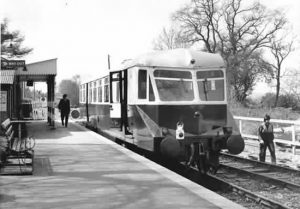
No. 20 was built by the Great Western Railway at Swindon in 1940. It is one of the fourth, and final, basic designs of railcar put into service by the GWR between 1934 and 1942.
Accommodation is provided for passengers in two open saloons having a total of 48 seats and there are driving cabs at either end. Two AEC diesel engines gave a top speed of 60 mph & the railcars were capable of hauling a tail load of up to 60 tons.

Purchased by the K&ESR, it arrived at Robertsbridge on 3 April 1966. Because of width restrictions on the Hastings line, it was necessary for the railcar's body to be weighted and tipped to one side, as an ‘out-of-gauge' load & it remains the widest load to have run on that route prior to the tunnels being singled ready for electrification in the 1980's.
It formed the first fare paying public train on 3 February 1974 and for the next five years it regularly ran Saturday morning and services. Although in mechanically sound condition, it was withdrawn from service during 1980 suffering badly from bodywork corrosion. Much painstaking work has been completed but the body has required an almost complete rebuild and the project continues as funding permits.
No.40 - 'Ford' diesel electric
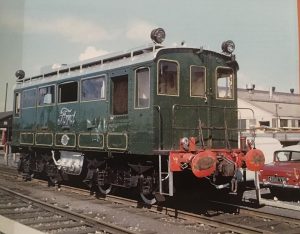 In 1931 the Ford Motor Company ordered three diesel-electric shunting locomotives for use at their new car plant at Dagenham in Essex. These locomotives owed something to an American ‘switcher' design, which first appeared in 1925 at Fords American plant. At the time of building they were unique in Britain and created considerable interest at home and abroad. Notably the specification stated "all materials will be of British manufacture...". The locomotives worked for 34 years at Dagenham, during which time each one is estimated to have run well in excess of 250,000 hours.
In 1931 the Ford Motor Company ordered three diesel-electric shunting locomotives for use at their new car plant at Dagenham in Essex. These locomotives owed something to an American ‘switcher' design, which first appeared in 1925 at Fords American plant. At the time of building they were unique in Britain and created considerable interest at home and abroad. Notably the specification stated "all materials will be of British manufacture...". The locomotives worked for 34 years at Dagenham, during which time each one is estimated to have run well in excess of 250,000 hours.
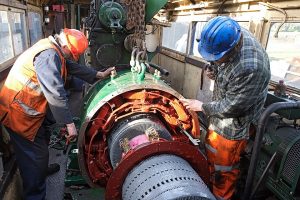
Ford No. 1 was acquired for the K&ESR and arrived on 7th July 1966, the locomotive having still been in use by Ford just two days previously. In February 1972 it hauled the last train from Robertsbridge to Bodiam, prior to the dismantling of that section of line. By 1986 it could usually be found working permanent way civil engineering trains. Following some restoration work, it returned to operating condition in 2000 but is only used on special occasions because of its great age.
M50971 & M51571 - Diesel Observation Train

These vehicles were introduced in the 1950's for duties on secondary lines and are in direct line of decent from the GWR Railcars, exemplified by No. 20 above and, earlier still, from the Ford and Shefflex railbuses pioneered by Colonel Stephens on the K&ESR. These vehicles are commonly referred to as the Diesel Mechanical Multiple Unit - or 'DMMU' for short! They were acquired for the K&ESR in 1993 and an extensive programme of renovation has since progressed steadily.
Both vehicles were constructed in 1959 and are now turned out in their original green livery. They are regularly used to supplement steam services on quieter days - their observation ends proving popular with passengers. One vehicle contains the guard's and luggage compartment, whilst the other features a first class saloon and lavatory.
08 359/D3429 - Class 08
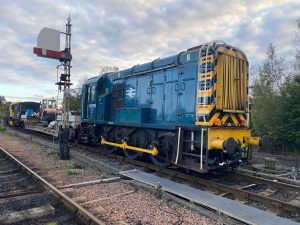 The Diesel Electric Shunter Company’s Class 08 Shunter 08 359 arrived at the Kent and East Sussex Railway in Autumn 2024 for an initial 2 year residency to join the railways expanding diesel fleet. Based at Rolvenden, the loco is primarily used as the Depot Shunter and for carriage shunting at Tenterden. One of its key roles however is the hauling of track engineering trains for the Permanent Way Department and will play its role as part of the extension works from Bodiam to Robertsbridge. Its current BR Rail Blue livery is representative of both its own history but also the wider class in the late 1970’s and early 1980’s.
The Diesel Electric Shunter Company’s Class 08 Shunter 08 359 arrived at the Kent and East Sussex Railway in Autumn 2024 for an initial 2 year residency to join the railways expanding diesel fleet. Based at Rolvenden, the loco is primarily used as the Depot Shunter and for carriage shunting at Tenterden. One of its key roles however is the hauling of track engineering trains for the Permanent Way Department and will play its role as part of the extension works from Bodiam to Robertsbridge. Its current BR Rail Blue livery is representative of both its own history but also the wider class in the late 1970’s and early 1980’s.
Built by the British Railways workshops at Crewe and entering traffic in March 1958, D3429 as it was originally numbered, worked most of its life in South Wales and survived with BR until March 1984, when mass closure of the coal mines in South Wales made it redundant. The loco is representative of the English Electric 350hp shunters that were built by British Railways between 1952 and 1962. Many of the class worked locally at Tonbridge, Ashford and Dover. 08 359 is a bit of a celebrity as it holds the distinction of being the oldest surviving diesel-electric locomotive built by Crewe Works. It entered preservation almost immediately and was purchased by the DESC in 2021 to join their small fleet. The loco has spent some time in Cornwall at the Bodmin Railway until March 2024 when the loco underwent an intermediate overhaul.
D9504 - Class 14
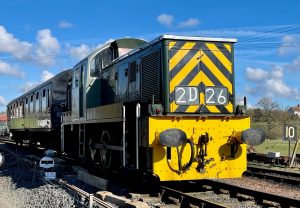
These Swindon-built locomotives were introduced in 1964 to work shunting duties, local freight and trip workings. They were introduced during the Beeching era - the very time when the work for which they were intended was rapidly disappearing! Thus they saw only two or three years' BR service and earned the nickname "Teddy bears". On the K&ESR D9504 has proved equally capable of handling heavy works trains or hauling the passenger services. D9504 was heavily involved in the building of the UK's first high speed line - High Speed 1.
D2023 & D2024 - Class 03
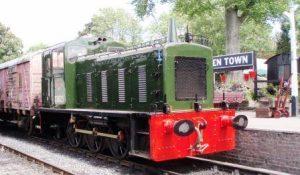
Two of these diminutive locos are on the K&ESR and have had a remarkably similar career. They were built at Swindon Works in 1958, to a similar design to those which were used on the Kent and East Sussex line during the final years of the BR freight service.
D2024 has yet to enter traffic and is on static display at Bodiam Station, but D2023 quickly received a major overhaul and re-entered service in Brunswick green livery. It has taken an active part in operating the railway but is usually to be found at Tenterden Town as the shunt pilot locomotive.
BR Class 20 20087 'Reginald T. Latham
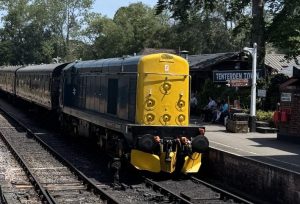 Designed by English Electric and built by Robert Stephenson and Hawthorns, it was created to work light mixed freight traffic. Unusually for British designs the locomotives had a single cab, this caused serious problems with visibility when travelling nose first. It was common practice to find Class 20 locomotives paired together nose to nose.
Designed by English Electric and built by Robert Stephenson and Hawthorns, it was created to work light mixed freight traffic. Unusually for British designs the locomotives had a single cab, this caused serious problems with visibility when travelling nose first. It was common practice to find Class 20 locomotives paired together nose to nose.
Withdrawn in November of 1995, 20087 was the sold into preservation where it was bought by a volunteer at the East Lancashire Railway. A major restoration took place by the volunteers at the ELR, once complete 20087 began hauling trains again.
After a stint at the East Lancashire Railway the locomotive was sold to the Harry Needle Railroad Company and was moved to Barrow Hill/Worksop where it then attended numerous events. It was then moved to the Battlefield Line (Shackerstone) where after some engine work the locomotive re-entered service.
In August the locomotive was purchased from HNRC by Road & Rail Steam Services Ltd, where after major restoration work the locomotive was moved to the Kent & East Sussex Railway on long term loan
1118 - Diesel Electric Multiple Unit
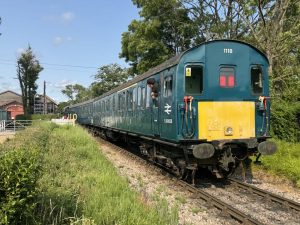 1118 is a member of the "Hampshire" fleet of Diesel Electric Multiple Units (DEMUs), later class 205, which were built at Eastleigh works in 1957 to replace steam traction on non electrified lines. It consists of a Motor Brake Second Coach containing the guards van and power unit, and a Driving Trailer Composite containing first and second class seating and toilets.
1118 is a member of the "Hampshire" fleet of Diesel Electric Multiple Units (DEMUs), later class 205, which were built at Eastleigh works in 1957 to replace steam traction on non electrified lines. It consists of a Motor Brake Second Coach containing the guards van and power unit, and a Driving Trailer Composite containing first and second class seating and toilets.
The new units entered service on branch lines in Hampshire and caused an instant increase in passenger numbers, as service quality and reliability increased whilst journey times were slashed. To counter the overcrowding that resulted from this, each unit had an additional Trailer Second added from 1959.
Due to the distinctive sound that the units make when taking power, they quickly gained the nickname of "Thumpers". A total of 34 units were built which in principle operated in Kent, Sussex, Hampshire, Surrey and Berkshire.
When 1118 first entered service, it was allocated to Eastleigh Depot, but by 1964 it had been reallocated to St Leonards Depot at Hastings where it was used on services between Ashford and Hastings, on the London to Oxted, Uckfield and East Grinstead lines, Three Bridges to Tunbridge Wells West and Uckfield to Lewes.
1118 was renumbered to 205018 in June 1986 but there were changes on the horizon with the electrification of the line to East Grinstead being completed in 1987. Some units were withdrawn but 1118 was reallocated to Selhurst Depot in South London to work on the Uckfield line and the Ashford to Hastings line. A repaint from Blue and Grey livery into Network SouthEast colours took place in April 1990.
205018 was withdrawn from service on the 17th August 2004 and sold into reservation, first going to the Pontypool & Bleanavon Railway, followed by the Meldon Line in Devon, and finally to Isfield on a route it would have previously worked.
Although Hampshire units have never worked over the K&ESR before, had the line not been closed to passenger in 1954 it is highly likely that they would have been used to provide a passenger service.
1118 is on loan to the K&ESR thanks to the kind support of its private owner.


